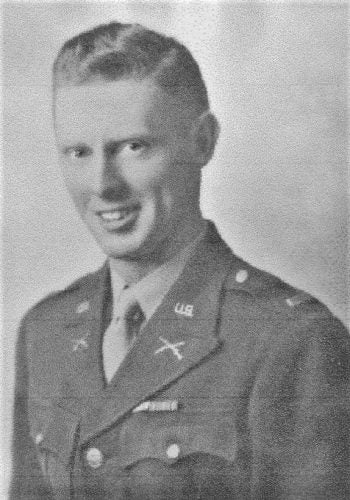- First Lieutenant
- WW II
Biography
Allen Edward Smith was born in Narragansett, Rhode Island in 1921. He was the son of Herbert and Grace Smith. He graduated from East Greenwich Academy in 1938. Allen entered Rhode Island State College (RISC) in September 1938 with the class of 1942, majoring in Business Administration. He participated in the Army ROTC program. Allen enlisted in the U.S. Army on 25 July 1941. His initial assignment was at Fort Jackson, South Carolina to attend Infantry Basic Training. Pvt. Smith was selected to attend Infantry Officer Candidate School (OCS) at the US Army Infantry School, Fort Benning, Georgia. He was commissioned a Second Lieutenant of Infantry upon graduation.
Allen volunteered for parachute training and was assigned to Fort Bragg, North Carolina for airborne and glider training. Upon completion of his training, Lieutenant Smith was assigned to the 82d Airborne Division, 325th Infantry Regiment as an Infantry Platoon Leader. The 82d Airborne Division deployed to North Africa in August 1942. The 325th was re- designated as the 325th Glider Infantry Regiment (Falcons), 82d Airborne Division.
On 15 September 1943, his unit arrived in Salerno, Italy, to reinforce American units already there. The following day, units of the 325th were ordered to re-board the landing craft and head farther north to the town of Maiori where they were attached to Colonel William O. Darby’s Ranger Task Force. The 325th relieved the Rangers and held positions on Mount St. Angelo di Cava. The Germans launched a few probing attacks against the 325th, but these were simply diversionary as the rest of the German army withdrew to their next line of defense. After service in the Italian Campaign, the regiment deployed to England to prepare for the invasion of France.
On 7 June 1944, the 325th regiment landed by glider in Normandy. The regiment was assigned the mission to capture a bridge across the Merderet River. The 325th fought in Normandy for over a month, sustaining heavy casualties before they withdrew to England to prepare for their next airborne/glider operation. The 325th’s next glider assault was in Holland during Operation Market Garden, the largest airborne operation ever conducted. On 23 September 1944, the 325th Glider Regiment landed near the Grave Bridge in the vicinity of Groesbeek, Holland. The landing was successful, and the 325th was immediately sent to reinforce elements of the 82d Airborne Division engaged in combat with German forces.
Sadly, First Lieutenant Allan Edward Smith was killed in action on 2 October 1944 near Katerbosch, Netherlands. He was awarded the Purple Heart and Combat Infantryman Badge. He was buried with full military honors in the Margraten American War Cemetery and Memorial, the Netherlands.
In 1945, the Dutch and people from surrounding countries established the “Adopt-A-Grave” program allowing citizens to adopt a grave of one or multiple American soldiers. They continue to decorate the graves with flowers to express their gratitude for these soldiers who have made the ultimate sacrifice for freedom. 1LT Allen E. Smith was a son of Rhode Island State College who answered the call to service during World War II and gave his life in service to Rhode Island and America. He was a member of the “Greatest Generation.”
Education
1942

